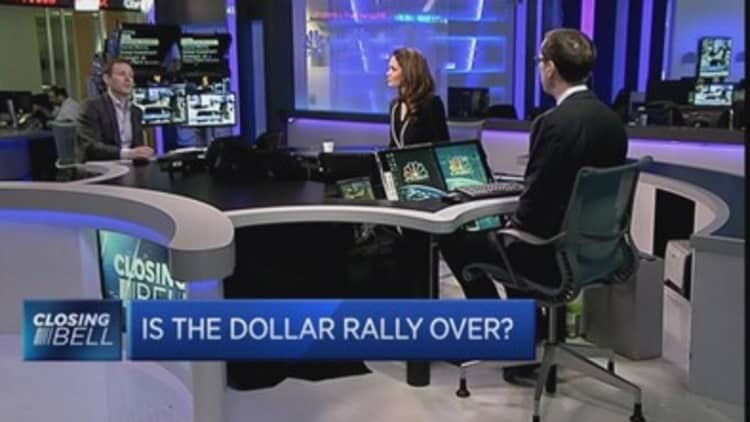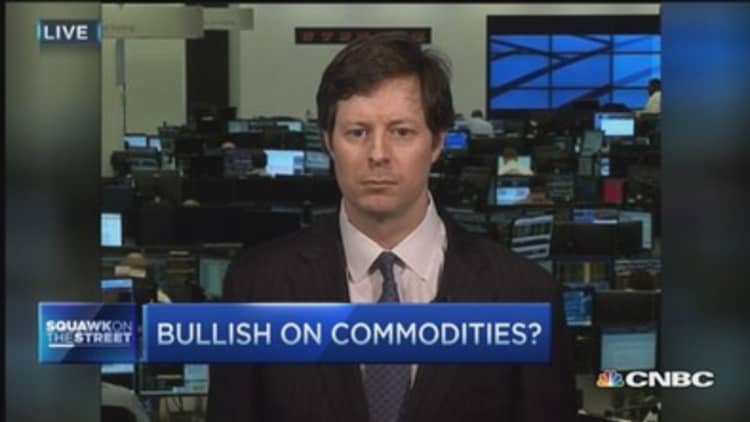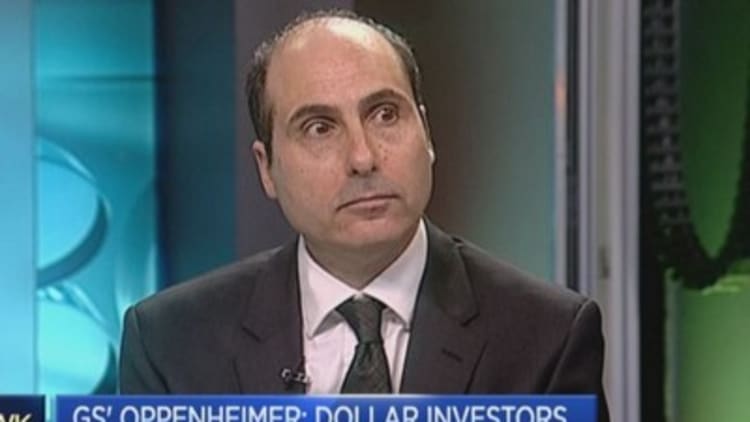


U.S. stocks closed lower on Monday as investors looked ahead to a light week of economic reports amid some consolidation in currency and oil prices.
"Right now the stock market is very hinged into how the dollar trades," said Robert Pavlik, chief market strategist at Boston Private Wealth. He noted that anytime the dollar drops, markets tend to gain. "That will key into (markets) until we get better economic reports."
The U.S. dollar fell about 1.5 percent against major world currencies, as the euro edged higher to trade near $1.09. The U.S. 10-year Treasury yield traded near 1.91 percent. Oil futures settles up 88 cents, at $47.45 a barrel, after touching a session low of $42.75 earlier.
Oil saw choppy trading after an initial decline on Saudi Arabia saying it would not unilaterally cut its output to defend prices over the weekend.
The Dow transports closed down nearly 2 percent as oil gained.
Read MoreProof that the rising dollar is good for stocks
The Dow Jones industrial average and S&P 500 traded just below all-time highs, turning negative in the close as the indices continued the alternating pattern of gains and losses they've held since February.
The Nasdaq struggled to stay positive but held above 5,000 in the close. Biotech stocks, which had led the index higher on Friday, were among the greatest laggards. The iShares Nasdaq Biotech (IBB) posted its first loss in 9 sessions, down 2.25 percent, the worst performance since Jan. 15 when the IBB lost 2.49 percent.
Biotechs weighing on Nasdaq 100 (as of March 23 close)
| Stock | Point Impact | Last | Chg | %Chg |
| Celgene (CELG) | -3.72 | 122.97 | -5.53 | -4.31% |
| Gilead Sciences (GILD) | -2.64 | 100.26 | -2.03 | -1.98% |
| Biogen (BIIB) | -2.48 | 463.73 | -12.25 | -2.57% |
| Amgen (AMGN) | -2.33 | 166.54 | -3.56 | -2.09% |
| Amazon.com (AMZN) | -1.36 | 375.11 | -3.38 | -0.89% |
The Russell 2000, a strong performer for the last few days, closed mildly lower, near all-time highs.
"As we get closer to the last few days of trading (for the first quarter) we're going to see more volatility," said Peter Cardillo, chief market economist at Rockwell Global Capital. "I think the market turns technical this week."
He expects the S&P 500 could reach 2,125 and the Nasdaq touch 5,075, which "will invite some selling" and lead to a technical correction in April.
European equities closed lower on Monday, with Greece in the spotlight as German Chancellor Angela Merkel and Greek Prime Minister Alexis Tsipras met in Berlin.
were up 1.2 percent, to an annual rate of 4.88 million units, slightly below expectations. No other economic data was due on Monday.
"I think the biggest thing is still if investors can get enough strength (from economic data) to get us through what's probably going to be a weak earnings season. Investors were encouraged by the news last week that the Fed would continue relaxing monetary policy," said Bruce McCain, chief investment strategist at Key Private Bank. But "at some point we need to see some stronger fundamentals."
In the next few days, inflation data, durable goods and the third read on fourth-quarter GDP round out a relatively light week of reports, with few companies reporting earnings.
"Now that investors have realized the Fed is going to move on data dependent, each piece of macroeconomic news that comes out on the weak side puts the timeframe of monetary policy change further away," said Cardillo said.
Vice Chair of the Fed Board of Governors Stanley Fischer said on Monday that a Fed Fund rate increase is likely this year.
A hike will be appropriate when the Fed sees "further improvement in the labor market" and is "reasonably confident" that inflation is moving back to 2 percent, he said before the Economic Club of New York.
Read MoreThis is what could drive stocks this week
Dovish comments from the Federal Reserve helped weaken the dollar last week, as expectations of a rate rise were pushed back.
St. Louis Federal Reserve President James Bullard said the strength in the U.S. dollar over recent months had mainly been due to the aggressive policies of the European Central Bank (ECB), rather than the Fed's potential move on rates.
Read MoreFed's Bullard: Markets could have another 'tantrum'
"(The dollar strength) really is the ECB," he told CNBC Monday. "They've resisted this for years."
Bullard also warned that global markets were facing a "mismatch" with the future of U.S. monetary policy and had the potential for major volatility.
"Last week was pretty volatile from the perspective of big swings in the market, not the VIX," said Randy Frederick, managing director of trading and derivatives at Charles Schwab. "I continue to see this as an indication the institutional players don't see much concern to the downside."
The CBOE Volatility Index (VIX), widely considered the best gauge of fear in the market, traded near 13.
U.S. stocks surged 1 percent on Friday, with the Dow and S&P breaking a three-week losing streak and the Nasdaq posting its second close above 5,000 since March 2009. Friday marked the eighth consecutive trading session in which the Dow and S&P 500 alternated between daily gains and losses, with the Dow moving triple-digits each day.
In corporate news:
Biogen—Stifel downgraded the stock to "hold," stating that the pharmaceutical company has reached a reasonable price target for the next 12 months.
Staples—UBS upgraded the stock to "buy," noting a favorable risk and reward proposition. The investment bank thinks the office supplies retailer will "more likely than not" be able to close its acquisition of Office Depot.
Pfizer—Jefferies added the pharmaceutical company to its "Franchise Picks" list, noting it expects the firm to show significant appreciation over the next one to two years based on better-than-expected launch of breast cancer drug Ibrance. The investment bank also saw potential for more merger and acquisition activity.
Cliffs Natural Resources announced it will sell Chromite assets in Canada to a local mining company, Noront Resources, for $20 million.
Read MoreEarly movers: Biogen, Staples, Pfizer & more
Tenet Healthcare and United Surgical Partners International (USPI) will combine to create the largest provider of ambulatory surgery in the United States in a cash and debt transaction valued at $1.93 billion.
The Dow Jones Industrial Average closed down 11.61 points, or 0.06 percent, at 18,116.04, with Pfizer leading gains and Home Depot the greatest laggard.
The closed down 3.68 points, or 0.17 percent, at 2,104.42, with consumer staples leading four sectors higher and industrials the greatest laggard.
The Nasdaq closed down 15.44 points, or 0.31 percent, at 5,010.97.
Advancers were a step ahead of decliners on the New York Stock Exchange, with an exchange volume of 727 million and a composite volume of 3.2 billion in the close.
High-frequency trading accounted for 47.5 percent of March's daily trading volume of about 6.6 billion shares, according to TABB Group. During the peak levels of high-frequency trading in 2009, about 61 percent of 9.8 billion of average daily shares traded were executed by high-frequency traders.
Gold futures closed up $3.10 at $1,187.70 an ounce.
Major U.S. Indexes
As of Friday's close:
- The Dow Jones industrial average was within 1.5 standard deviations above its 50-day moving average. Since 1981 the index has been in this position 8.36 percent of all trading days, according to quantitative analytics tool Kensho. The probability of the index moving lower is 60.6 percent and the probability of it moving higher in the days following is 39.4 percent.
- The S&P 500 was within 1.5 standard deviations above its 50-day moving average. Since 1980 the index has been in this position 8.32 percent of all trading days, according to Kensho. The probability of the index moving higher in the days following is 45.1 percent and the probability of it moving lower is 54.9 percent.
- The Nasdaq composite was within two standard deviations above its 50-day moving average. Since 1980 the index has been in this position 9.28 percent of all trading days, according to Kensho. The probability of the index moving lower is 75.8 percent and the probability of it moving higher is 24.2 percent.
—CNBC.com contributed to this report.
Disclosure: CNBC's parent NBCUniversal is a minority investor in Kensho.
On tap this week:
Tuesday
Earnings: HD Supply Holdings, McCormick, Sonic, Steelcase
6:05 am: St. Louis Fed President James Bullard in London
8:30 am: CPI
9:00 am: FHFA
9:45 am: Manufacturing PMI
10:00 am: New home sales
1:00 pm: $26 billion two-year note auction
10:00 pm: San Francisco Fed President John Williams in Australia
Wednesday
Earnings: Paychex, Apollo Education Group, Yingli Green Energy, Red Hat, Five Below, Worthington Industries
6:30 am: Chicago Fed President Charles Evans in London
8:30 am: Durable goods
11:30 am: $13 billion two-year floating-rate notes
1:00 pm: $35 billion five-year note auction
Thursday
Earnings: ConAgra, Accenture, Lululemon Athletica, Gamestop,Restoration Hardware, Scholastic, Commercial Metals
8:30 am: Initial claims
9:45 am: Services PMI
1:00 pm: $29 billion seven-year note auction
Friday
Earnings: BlackBerry
6:30 am: Fed Vice Chairman Fischer speaks in Germany
8:30 am: Real GDP (Q4 third)
10:00 am: Consumer sentiment
10:00 am: Atlanta Fed President Dennis Lockhart in Detroit
3:45 pm: Fed Chair Janet Yellen on monetary policy in San Francisco, Q&A
More From CNBC.com:


